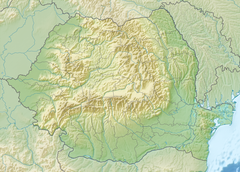Peștera Muierilor
 Speleothems in the cave | |
| Alternative name | Peștera Muierii |
|---|---|
| Location | Baia de Fier, Gorj County, Romania |
| Coordinates | 45°11′31″N 23°45′13″E / 45.19194°N 23.75361°E |
| Type | multi-chambered karstic cave |
| History | |
| Periods | Paleolithic |
| Site notes | |
| Excavation dates | 1951–1953, 1955 |
| Archaeologists | Constantin S. Nicolăescu-Plopșor |
Peștera Muierilor, or Peștera Muierii (
The human skull is that of a woman with obvious
On the basis of radiocarbon dating and also the analysis of the archaeological context, some researchers advanced the hypothesis of the association of these bones with Cro-Magnons and the Aurignacian archaeological culture. Others mention the possibility that these findings could belong to a certain regional culture from the Southern Carpathians, from the period of the Final Middle Paleolithic and Early Upper Paleolithic.
DNA analysis
The remains of three individuals were found at the site.
A full genome study conducted on the remains in 2021 revealed that the Peștera Muierii woman is related to modern Europeans, but not a direct ancestor. The woman also displays close genetic affinities to other Paleolithic Europeans, such as
See also
- Peștera cu Oase
- Prehistoric Romania
- Prehistoric Transylvania
- Prehistoric Southeastern Europe
- Prehistoric Europe

